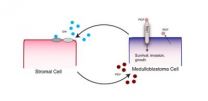(Press-News.org) Accelerating a free electron with a laser has been a longtime goal of solid-state physicists.
David Cline, a distinguished professor in the UCLA Department of Physics and Astronomy, and Xiaoping Ding, an assistant researcher at UCLA, have conducted research at Brookhaven National Laboratory in New York and have established that an electron beam can be accelerated by a laser in free space.
This has never been done before at high energies and represents a significant breakthrough, Cline said, adding that it also may have implications for fusion as a new energy source.
In free space, a plane-wave laser is unable to accelerate an electron, according to the Lawson–Woodward theorem, posited in 1979. However, Yu-kun Ho, a professor at China's Fudan University in Shanghai, and his research group have proposed a concept of what physicists refer to as the capture–acceleration scenario to show that an electron can be accelerated by a tightly focused laser in a vacuum.
In the capture–acceleration scenario, the diffraction from a tightly focused laser changes not only the intensity distribution of the laser but also its phase distribution, which results in the field phase velocity being lower than the speed of light in a vacuum in some areas.
Thus, a channel that overlaps features of both strong longitudinal electric field and low–laser-phase velocity is created, and electrons can receive energy gain from the laser. The acceleration effect increases along with increasing laser intensity, Cline said. This channel for electrons may be useful for other scientific endeavors, such as guiding an electron beam into a specific region of laser fusion applications, he said.
A possible application of this discovery is the use of laser plasma fusion to provide a new energy source for the U.S. and other countries. The focus of the laser generates a natural channel that can capture electrons and drive them into a pellet that explodes, by fusion, to produce excess energy, Cline said.
With federal funding from the U.S. Department of Energy, a project to carry out a proof-of-principle beam test for the novel vacuum acceleration at Brookhaven National Laboratory's Accelerator Test Facility (BNL-ATF) has been proposed and approved — a collaboration among the UCLA Center for Advanced Accelerators, of which Cline is principal investigator, Ho's group and the Accelerator Test Facility team.
BNL-ATF is one of the few facilities that can provide both a high-quality electron beam and a high-intensity laser beam for the beam test, Cline said. Ho's group provides theoretical support. UCLA scientists — Cline, Ding and Lei Shao, a former UCLA physics graduate student of Cline's — are responsible for the whole experiment and the experimental data analysis.
Simulation research work and hardware design have been done in accordance with BNL-ATF's experimental conditions. The simulation results predict that vacuum laser acceleration phenomena can be observed with ATF's diagnostic system.
Cline, Ding, Ho and their colleagues published two papers last month on this research: "Simulation Prediction and Experiment Setup of Vacuum Laser Acceleration at Brookhaven National Lab-Accelerator Test Facility," in the journal Nuclear Instruments and Methods in Physics Research A, and the discovery paper "First Observation of Acceleration of Electrons by a Laser in a Vacuum," in the Journal of Modern Physics.
The major result of the experiment is to show the increase of beam energy caused by the laser, as illustrated in the attached graph of data collected from the spectrometer on beam line No. 1 at BNL-ATF. Each row of two frames represents one snapshot-pair of "laser on" (right side) and "laser off" (left side) with unchanged configuration. One can see a clear increase from these pictures, proof that the laser accelerates the 20 mega-electron-volts electron beam in vacuum. The length of the beam image reveals the energy spread of the beam. The experiment recorded 30 shots. Twenty shots were high-intensity and showed effects of the laser on/laser off difference. Four shot examples are shown in the graph.
UCLA 'Higgs factory' workshop: March 21
The UCLA Department of Physics and Astronomy will sponsor a workshop from March 21 to 23 on the Higgs boson and the development of a Higgs factory muon collider. Topics at the workshop will include the latest results from the Large Hadron Collider and the importance of the Higgs boson particle. For more information, visit http://ucla.in/V85UyL.
"The discovery of the Higgs boson last July 4 is one of the greatest discoveries of all time and a key to understanding the universe," Cline said. "However, in order to study this in detail, a new source must be built to produce hundreds of thousands of Higgs particles per year and to study the detailed properties that could tell us more about the origin of this particle and other new physics. This UCLA workshop will discuss 'Higgs factories.' We expect experts in accelerator physics, cosmology and particle physics to attend. With interest building after the discovery of a particle consistent with the Higgs boson, doors are opening to a new range of questions and discussions."
###UCLA is California's largest university, with an enrollment of more than 40,000 undergraduate and graduate students. The UCLA College of Letters and Science and the university's 11 professional schools feature renowned faculty and offer 337 degree programs and majors. UCLA is a national and international leader in the breadth and quality of its academic, research, health care, cultural, continuing education and athletic programs. Six alumni and six faculty have been awarded the Nobel Prize.
For more news, visit the UCLA Newsroom and follow us on Twitter.
Physicists demonstrate the acceleration of electrons by a laser in a vacuum
2013-02-28
ELSE PRESS RELEASES FROM THIS DATE:
New protein quality method provides important information on sustainable diet
2013-02-28
Rosemont, IL (February 27, 2013) – A groundbreaking report by an Expert Consultation of the Food and Agriculture Organization of United Nations (FAO) has recommended a new, advanced method for assessing the quality of dietary proteins.
The report, "Dietary protein quality evaluation in human nutrition", recommends that the Digestible Indispensable Amino Acid Score (DIAAS) replace the Protein Digestibility Corrected Amino Acid Score (PDCAAS) as the preferred method of measuring protein quality. The report recommends that more data be developed to support full implementation, ...
Mutation location is the key to prognosis
2013-02-28
HOUSTON – (Feb. 28, 2013) – The three most important factors in real estate are location, location, location, and the same might be said for mutations in the gene MECP2, said researchers at Baylor College of Medicine and the Jan and Dan Duncan Neurological Research Institute (NRI) at Texas Children's Hospital in a report in the journal Cell.
"Where a mutation occurs can affect the severity of the symptoms of the disease," said Dr. Huda Zoghbi, professor of molecular and human genetics at BCM and director of the NRI. Zoghbi, corresponding author of the report, found the ...
UCLA study could explain why some people get zits and others don't
2013-02-28
The bacteria that cause acne live on everyone's skin, yet one in five people is lucky enough to develop only an occasional pimple over a lifetime. What's their secret?
In a boon for teenagers everywhere, a UCLA study conducted with researchers at Washington University in St. Louis and the Los Angeles Biomedical Research Institute has discovered that acne bacteria contain "bad" strains associated with pimples and "good" strains that may protect the skin.
The findings, published in the Feb. 28 edition of the Journal of Investigative Dermatology, could lead to a myriad ...
Action video games boost reading skills
2013-02-28
Much to the chagrin of parents who think their kids should spend less time playing video games and more time studying, time spent playing action video games can actually make dyslexic children read better. In fact, 12 hours of video game play did more for reading skills than is normally achieved with a year of spontaneous reading development or demanding traditional reading treatments.
The evidence, appearing in the Cell Press journal Current Biology on February 28, follows from earlier work by the same team linking dyslexia to early problems with visual attention rather ...
Fighting GM crop vandalism with a government-protected research site
2013-02-28
Genetically modified (GM) crops have been a source of great controversy—particularly in Europe—but acts of vandalism and associated security costs have made scientific evidence about the health and ecological impacts of those crops hard to come by. A Swiss government-protected field site dedicated for use in GM crop studies could serve as an example to other European countries interested in pursuing crop biotechnology, according to an article published in Trends in Biotechnology, a Cell Press publication, on February 28.
The protected field site will now enable research ...
Study identifies growth factor essential to the most common malignant pediatric brain tumor
2013-02-28
A multi-institutional team led by Massachusetts General Hospital (MGH) researchers has identified a molecular pathway that appears to be essential for the growth and spread of medulloblastoma, the most common malignant brain tumor in children. In their report in the Feb. 28 issue of Cell, they show that blocking this pathway – which involves interactions between tumor cells and the surrounding tissues – leads to regression of all four molecular subtypes of medulloblastoma in several mouse models.
"Our finding that a pathway carrying signals from host cells to tumor cells ...
How did early primordial cells evolve?
2013-02-28
VIDEO:
L-form bacteria undergoes cell division. The time scale is in minutes.
Click here for more information.
Four billion years ago, soon after the planet cooled enough for life to begin, primordial cells may have replicated and divided without protein machinery or cell walls, relying instead on just a flimsy lipid membrane. New research on bacteria examines exactly how these primitive cells could have evolved without such crucial structures. While the vast majority of bacteria ...
Animas' development of a first-generation closed loop insulin delivery system progresses
2013-02-28
WEST CHESTER, Pa., February 28, 2013 – Animas Corporation announced today positive results from the second phase of human clinical trials of a first-generation, closed-loop insulin delivery system in development, designed to predict a rise or fall in blood glucose and correspondingly increase, decrease, suspend and resume insulin delivery. The data were presented at the Advanced Technologies & Treatments for Diabetes (ATTD) Conference in Paris, France.
The feasibility study of the predictive Hypoglycemia-Hyperglycemia Minimizer (HHM) System* in development was conducted ...
The birth of a giant planet?
2013-02-28
An international team led by Sascha Quanz (ETH Zurich, Switzerland) has studied the disc of gas and dust that surrounds the young star HD 100546, a relatively nearby neighbour located 335 light-years from Earth. They were surprised to find what seems to be a planet in the process of being formed, still embedded in the disc of material around the young star. The candidate planet would be a gas giant similar to Jupiter.
"So far, planet formation has mostly been a topic tackled by computer simulations," says Sascha Quanz. "If our discovery is indeed a forming planet, then ...
Secondary facelift achieves good results, reports plastic and reconstructive surgery
2013-02-28
Philadelphia, Pa. (February 28, 2013) – Performed an average of a decade after initial facelift surgery, a "secondary" facelift can achieve similarly lasting results with a low complication rate, according to a paper in the March issue of Plastic and Reconstructive Surgery®, the official medical journal of the American Society of Plastic Surgeons (ASPS).
Dr. Rod J. Rohrich and colleagues of University of Southwestern Medical Center, Dallas, report their 20-year experience with secondary facelift surgery, or "rhytidectomy." The researchers conclude that, with attention ...



